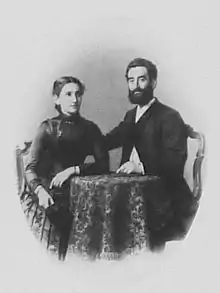Leonhard Tietz
Leonhard Tietz (March 3 1849 - November 14 1914) was a German department store entrepreneur and art collector of Jewish origin.[1]

Biography
Born in Birnbaum an der Warthe, Province of Posen, Prussia (today Międzychód, Poland), Leonhard Tietz was the brother of Oskar Tietz and a founding member of the Tietz Department store dynasty. On 14 August 1879, he opened his first department store in Stralsund, with the idea of selling high-quality products at fixed prices for cash. He was the first to introduce a money-back guarantee. In 1891, a shop was opened in Cologne.
In 1905, his enterprise was transformed into a joint stock company.
Art collector
Tietz owned an art collection which included paintings by Vincent van Gogh and Paul Cézanne. In 1912 he lent a self portrait by van Gogh and a still-life by Cézanne ("Stilleben, Früchte mit Glas und Porsellanschale") to the famous Sonderbund Exhibition in Cologne (Internationale Kunstausstellung des Sonderbundes Westdeutscher Kunstfreunde und Künstler zu Cöln).[2]
Legacy and loss
After Tietz's death, his son Alfred Leonhard Tietz led the Tietz firm. In 1933, the Nazi Party came to power in Germany and Jewish businesses were targeted.[3]
The Nazi policy of racial discrimination and anti-semitic harassment of Jewish-managed firms hurt the Tietzs' department store and other businesses.[4] The business was renamed Westdeutsche Kaufhof AG. In an "Aryanisation" (the obligatory transfer of Jewish businesses to non-Jewish owners),[5][6] the Tietz family was forced to sell their shares under market value. They fled Nazi Germany. After the Allied victory, they received some compensation estimated at 5 million DM.
Today, the department store chain Galeria Kaufhof is the direct descendant of the tiny shop opened in 1879.
References
- "The Tietz Famiy" (PDF). Archived from the original (PDF) on 2020-09-27.
- Sonderbund Westdeutscher Kunstfreunde und Künstler (1912). Internationale Kunstausstellung des Sonderbundes Westdeutscher Kunstfreunde und Künstler zu Cöln, 1912. Solomon R. Guggenheim Museum Library. Cöln a. Rhein : M. Dumont Schauberg.
- The Attack on Berlin Department Stores (Warenhaeuser) After 1933 Simone Ladwig-Winters published by Yad Vashem https://www.yadvashem.org/odot_pdf/Microsoft%20Word%20-%205622.pdf
- Stock Market Performance of Jewish Firms During the Third Reich https://www.wiwi.uni-konstanz.de/typo3temp/secure_downloads/85539/0/e1c9300496b7624a1c5f62720b94796f91d46780/Version25_1_.pdf
- Katin, William M. (2018). A Re-Assessment of Aryanization of Large Jewish Companies in Hitler's Reich, 1933-1935: The Role of Conservative, Non-Nazi Businessmen (Thesis).
- Huber, Kilian; Lindenthal, Volker; Waldinger, Fabian (1 September 2021). "Discrimination, Managers, and Firm Performance: Evidence from 'Aryanizations' in Nazi Germany" (PDF). Journal of Political Economy. 129 (9): 2455–2503. doi:10.1086/714994. S2CID 169530350.
External links
 Media related to Leonhard Tietz at Wikimedia Commons
Media related to Leonhard Tietz at Wikimedia Commons- Documents and clippings about Leonhard Tietz AG in the 20th Century Press Archives of the ZBW